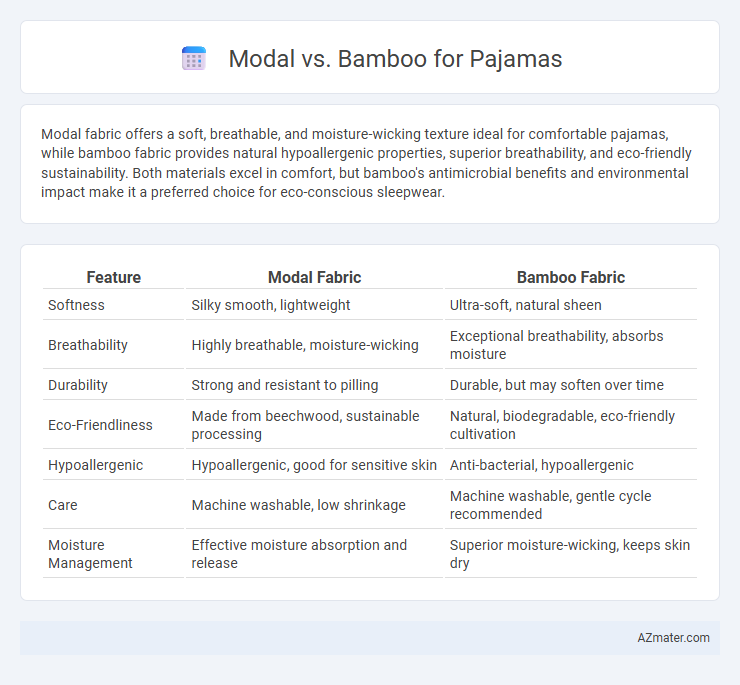Modal fabric offers a soft, breathable, and moisture-wicking texture ideal for comfortable pajamas, while bamboo fabric provides natural hypoallergenic properties, superior breathability, and eco-friendly sustainability. Both materials excel in comfort, but bamboo's antimicrobial benefits and environmental impact make it a preferred choice for eco-conscious sleepwear.
Table of Comparison
| Feature | Modal Fabric | Bamboo Fabric |
|---|---|---|
| Softness | Silky smooth, lightweight | Ultra-soft, natural sheen |
| Breathability | Highly breathable, moisture-wicking | Exceptional breathability, absorbs moisture |
| Durability | Strong and resistant to pilling | Durable, but may soften over time |
| Eco-Friendliness | Made from beechwood, sustainable processing | Natural, biodegradable, eco-friendly cultivation |
| Hypoallergenic | Hypoallergenic, good for sensitive skin | Anti-bacterial, hypoallergenic |
| Care | Machine washable, low shrinkage | Machine washable, gentle cycle recommended |
| Moisture Management | Effective moisture absorption and release | Superior moisture-wicking, keeps skin dry |
Introduction to Modal and Bamboo Fabrics
Modal fabric, derived from beech tree cellulose, is renowned for its softness, breathability, and moisture-wicking properties, making it an excellent choice for comfortable pajamas. Bamboo fabric, produced from bamboo pulp, offers natural antibacterial qualities, high absorbency, and eco-friendly benefits, enhancing pajama wear with sustainable comfort. Both fabrics are valued for their smooth textures and durability, but Modal excels in silky softness while Bamboo is preferred for its environmental impact and hypoallergenic features.
Sustainability: Bamboo vs Modal Pajamas
Modal pajamas and bamboo pajamas both offer sustainable fabric options, but they differ in environmental impact and production methods. Bamboo pajamas are derived from bamboo pulp, which grows rapidly and requires minimal pesticides, making it a highly renewable resource. Modal, primarily sourced from beech trees, involves an eco-friendlier production process with closed-loop systems that recycle water and solvents, enhancing its sustainability credentials compared to traditional fabrics.
Softness and Comfort Comparison
Modal fabric offers exceptional softness due to its cellulose-based fibers that feel silky and smooth against the skin, making it a top choice for comfortable pajamas. Bamboo fabric also excels in softness and is naturally hypoallergenic and breathable, enhancing overall comfort and moisture-wicking properties. When comparing softness and comfort, modal typically provides a more luxurious, silky touch, while bamboo excels in temperature regulation and is ideal for sensitive skin.
Moisture-Wicking and Breathability
Modal fabric offers excellent moisture-wicking properties thanks to its semi-synthetic fiber structure derived from beech trees, allowing sweat to evaporate quickly and keeping the skin dry. Bamboo fabric excels in breathability with its natural porous structure, promoting airflow and reducing heat retention for a cooler sleep experience. Both materials provide superior comfort in pajamas, but bamboo's antimicrobial qualities add an extra layer of freshness.
Durability and Longevity
Modal fabric offers superior durability compared to bamboo, resisting pilling and maintaining softness even after multiple washes, making it ideal for long-lasting pajamas. Bamboo fibers, while naturally breathable and moisture-wicking, tend to weaken faster due to their delicate structure and require gentle care to extend longevity. Choosing modal pajamas ensures sustained comfort and shape retention over time, whereas bamboo pajamas provide eco-friendly benefits but may need more frequent replacement.
Skin Sensitivity and Hypoallergenic Properties
Modal fabric offers exceptional softness and breathability, making it ideal for sensitive skin and reducing irritation risks in pajamas. Bamboo fibers naturally possess hypoallergenic properties that repel allergens and moisture, promoting a comfortable and irritation-free sleep environment. Both fabrics excel in gentle wearability, but bamboo enhances allergy resistance with its antimicrobial benefits.
Environmental Impact: Modal vs Bamboo
Modal pajamas, made from beech tree cellulose, utilize a closed-loop production process that significantly reduces water and energy consumption, making them more environmentally sustainable than traditional fabrics. Bamboo pajamas leverage fast-growing bamboo plants with natural antibacterial properties, but their production often involves chemical-intensive processing methods that can harm ecosystems unless certified eco-friendly. Choosing modal over bamboo pajamas can decrease environmental footprint due to less chemical use, lower water consumption, and biodegradable materials.
Ease of Care and Maintenance
Modal fabric is prized for its durability and resistance to shrinking, making pajama care straightforward with machine washing in cold water and low-heat drying, while bamboo requires more delicate handling to preserve its softness, often advising gentle washing and air drying. Both materials resist wrinkles, but modal maintains shape better over time with less pilling compared to bamboo. For low-maintenance pajamas, modal offers superior ease of care, whereas bamboo's eco-friendly appeal comes with a need for more attentive laundering.
Price Point and Value for Money
Modal pajamas often sit at a mid-range price point, offering exceptional softness, breathability, and moisture-wicking properties that justify their cost. Bamboo pajamas typically come at a similar or slightly higher price, valued for their eco-friendly production and hypoallergenic features. When considering value for money, Modal provides a luxurious feel at a competitive price, while Bamboo offers sustainable benefits that appeal to environmentally conscious buyers.
Choosing the Right Fabric for Your Pajamas
Modal pajamas offer exceptional softness and breathability, making them ideal for sensitive skin and hot sleepers, while bamboo fabric is naturally moisture-wicking, hypoallergenic, and eco-friendly, providing excellent temperature regulation. When choosing the right fabric for pajamas, consider factors such as comfort, sustainability, and moisture management to enhance sleep quality. Both modal and bamboo fabrics deliver durability and a luxurious feel, but bamboo excels in natural antibacterial properties, making it a superior choice for those with allergies or skin sensitivities.

Infographic: Modal vs Bamboo for Pajama
 azmater.com
azmater.com